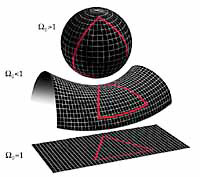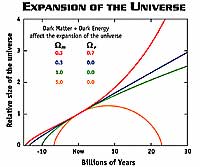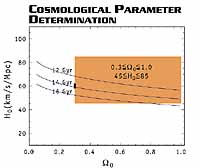
Foundations of Big Bang Cosmology
The Big Bang model of cosmology rests on two key ideas that date back to the early 20th century: General Relativity and the Cosmological Principle. By assuming that the matter in the universe is distributed uniformly on the largest scales, one can use General Relativity to compute the corresponding gravitational effects of that matter. Since gravity is a property of space-time in General Relativity, this is equivalent to computing the dynamics of space-time itself. The story unfolds as follows:
 Given the assumption that the
matter in the universe is homogeneous and isotropic (The Cosmological Principle) it can be shown
that the corresponding distortion of space-time (due to the gravitational effects of this
matter) can only have one of three forms, as shown schematically in the picture at left. It can
be "positively" curved like the surface of a ball and finite in extent; it can be
"negatively" curved like a saddle and infinite in extent; or it can be
"flat" and infinite in extent - our "ordinary" conception of space. A key
limitation of the picture shown here is that we can only portray the curvature of a
2-dimensional plane of an actual 3-dimensional space! Note that in a closed universe you could
start a journey off in one direction and, if allowed enough time, ultimately return to your
starting point; in an infinite universe, you would never return.
Given the assumption that the
matter in the universe is homogeneous and isotropic (The Cosmological Principle) it can be shown
that the corresponding distortion of space-time (due to the gravitational effects of this
matter) can only have one of three forms, as shown schematically in the picture at left. It can
be "positively" curved like the surface of a ball and finite in extent; it can be
"negatively" curved like a saddle and infinite in extent; or it can be
"flat" and infinite in extent - our "ordinary" conception of space. A key
limitation of the picture shown here is that we can only portray the curvature of a
2-dimensional plane of an actual 3-dimensional space! Note that in a closed universe you could
start a journey off in one direction and, if allowed enough time, ultimately return to your
starting point; in an infinite universe, you would never return.
Before we discuss which of these three pictures describe our universe (if any) we must make a few disclaimers:
- Because the universe has a finite age (~13.77 billion years) we can only see a finite distance out into space: ~13.77 billion light years. This is our so-called horizon. The Big Bang Model does not attempt to describe that region of space significantly beyond our horizon - space-time could well be quite different out there.
- It is possible that the universe has a more complicated global topology than that which is portrayed here, while still having the same local curvature. For example it could have the shape of a torus (doughnut). There may be some ways to test this idea, but most of the following discussion is unaffected.
Matter plays a central role in cosmology. It turns out that the average density of matter uniquely determines the geometry of the universe (up to the limitations noted above). If the density of matter is less than the so-called critical density, the universe is open and infinite. If the density is greater than the critical density the universe is closed and finite. If the density just equals the critical density, the universe is flat, but still presumably infinite. The value of the critical density is very small: it corresponds to roughly 6 hydrogen atoms per cubic meter, an astonishingly good vacuum by terrestrial standards! One of the key scientific questions in cosmology today is: what is the average density of matter in our universe? While the answer is not yet known for certain, it appears to be tantalizingly close to the critical density.
 Given a law of gravity and an assumption
about how the matter is distributed, the next step is to work out the dynamics of the universe -
how space and the matter in it evolves with time. The details depend on some further information
about the matter in the universe, namely its density (mass per unit volume) and its pressure
(force it exerts per unit area), but the generic picture that emerges is that the universe
started from a very small volume, an event later dubbed the Big Bang, with an initial expansion
rate. For the most part this rate of expansion has been slowing down (decelerating) ever
since due to the gravitational pull of the matter on itself. A key question for the fate of the
universe is whether or not the pull of gravity is strong enough to ultimately reverse the
expansion and cause the universe to collapse back on itself. In fact, recent observations have
raised the possibility that the expansion of the universe might in fact be speeding up
(accelerating), raising the possibility that the evolution of the universe is now dominated by a
bizarre form of matter which has a negative pressure.
Given a law of gravity and an assumption
about how the matter is distributed, the next step is to work out the dynamics of the universe -
how space and the matter in it evolves with time. The details depend on some further information
about the matter in the universe, namely its density (mass per unit volume) and its pressure
(force it exerts per unit area), but the generic picture that emerges is that the universe
started from a very small volume, an event later dubbed the Big Bang, with an initial expansion
rate. For the most part this rate of expansion has been slowing down (decelerating) ever
since due to the gravitational pull of the matter on itself. A key question for the fate of the
universe is whether or not the pull of gravity is strong enough to ultimately reverse the
expansion and cause the universe to collapse back on itself. In fact, recent observations have
raised the possibility that the expansion of the universe might in fact be speeding up
(accelerating), raising the possibility that the evolution of the universe is now dominated by a
bizarre form of matter which has a negative pressure.
The picture above shows a number of possible scenarios for the relative size of the universe vs. time: the bottom (green) curve represents a flat, critical density universe in which the expansion rate is continually slowing down (the curves becomes ever more horizontal). The middle (blue) curve shows an open, low density universe whose expansion is also slowing down, but not as much as the critical density universe because the pull of gravity is not as strong. The top (red) curve shows a universe in which a large fraction of its mass/energy may be in the very fabric of space itself, a leading candidate for the so-called "dark energy" which is causing the expansion of the universe to speed up (accelerate). This energy is often referred to as a "cosmological constant", though it now refers to energy pushing the universe apart, where as Einstein invented the term to balance his equations for a fixed-sized universe. There is growing evidence that our universe is following the red curve.
Please keep in mind the following important points to avoid misconceptions about the Big Bang and expansion:
- The Big Bang did not occur at a single point in space as an "explosion." It is better thought of as the simultaneous appearance of space everywhere in the universe. That region of space that is within our present horizon was indeed no bigger than a point in the past. Nevertheless, if all of space both inside and outside our horizon is infinite now, it was born infinite. If it is closed and finite, then it was born with zero volume and grew from that. In neither case is there a "center of expansion" - a point from which the universe is expanding away from an origin point. In the ball analogy, the radius of the ball grows as the universe expands, but all points on the surface of the ball (the universe) recede from each other in an identical fashion. The interior of the ball should not be regarded as part of the universe in this analogy.
- By definition, the universe encompasses all of space and time as we know it, so it is beyond the realm of the Big Bang model to postulate what the universe is expanding into. In either the open or closed universe, the only "edge" to space-time occurs at the Big Bang (and perhaps its counterpart the Big Crunch), so it is not logically necessary (or sensible) to consider this question.
- It is beyond the realm of the Big Bang Model to say what gave rise to the Big Bang. There are a number of speculative theories about this topic, but none of them make realistically testable predictions as of yet.
 Thus far,
the only assumption we have made about the universe is that its matter is distributed
homogeneously and isotropically on large scales. There are a number of free parameters in this
family of Big Bang models that must be fixed by observations of our universe. The most important
ones are: the geometry of the universe (open, flat or closed); the present expansion rate (the
Hubble constant); and the overall course of expansion, past and future, which is determined by the
fractional density of the different types of matter in the universe. Note that the present age
of the universe follows from the expansion history and present expansion rate.
Thus far,
the only assumption we have made about the universe is that its matter is distributed
homogeneously and isotropically on large scales. There are a number of free parameters in this
family of Big Bang models that must be fixed by observations of our universe. The most important
ones are: the geometry of the universe (open, flat or closed); the present expansion rate (the
Hubble constant); and the overall course of expansion, past and future, which is determined by the
fractional density of the different types of matter in the universe. Note that the present age
of the universe follows from the expansion history and present expansion rate.
As noted above, the geometry and evolution of the universe are determined by the fractional contribution of various types of matter. Since both energy density and pressure contribute to the strength of gravity in General Relativity, cosmologists classify types of matter by its "equation of state" the relationship between its pressure and energy density. The basic classification scheme is:
- Radiation: composed of massless or nearly massless particles that move at the speed of light. Known examples include photons (light) and neutrinos. This form of matter is characterized by having a large positive pressure.
- Baryonic matter: In this cosmological context, this is "ordinary matter" composed primarily of protons, neutrons and electrons. This form of matter has essentially no pressure of cosmological importance.
- Dark matter: this generally refers to "exotic" non-baryonic matter that interacts only weakly with ordinary matter. While no such matter has ever been directly observed in the laboratory, its existence has long been suspected for reasons discussed in a subsequent page. This form of matter also has no cosmologically significant pressure.
- Dark energy: this is a truly bizarre form of matter, or perhaps a property of the vacuum itself, that is characterized by a large, negative pressure (repelling force). This is the only form of matter that can cause the expansion of the universe to accelerate, or speed up.
One of the central challenges in cosmology today is to determine the relative and total densities (energy per unit volume) in each of these forms of matter, since this is essential to understanding the evolution and ultimate fate of our universe.
